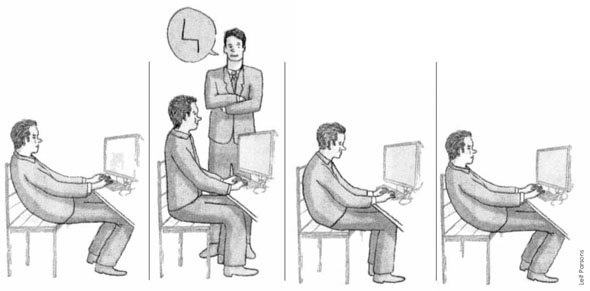Stretching Phase
When a metal spring is pulled initially, the material stretches to accommodate the increase in pressure. In much the same way, the people involved in a process-improvement project generally find themselves stretching and willing to tackle all necessary tasks in the early going.
At the aerospace company, an improvement project typically began with the formation of a team consisting of 10 to 18 members from various departments. A Six Sigma or other improvement expert was assigned to the team to guide and train them. At this stage, teams were excited to learn and apply what they were being taught.
Team members collected data on their current working environment and, with the help of the Six Sigma expert, identified the changes they most needed to make to achieve their stated goal—say, a reduction in the rate of defects in manufactured parts or fewer mistakes in order writing and billing. The expert developed a “to do” list that included action items, responsibilities and deadlines and made sure needed resources were available.
Because top executives were paying close attention to the project at this stage, managers made clear to employees that the improvement initiative was their top priority. For example, producing error-free bills became more important than processing a certain quantity of bills each day.
While daily production slipped initially when the team transitioned to the new way of working, it improved when the group grew accustomed to the new process. When the team reached its goal—say it reduced billing errors by a certain percentage—the improvement project was declared a success.
The director who was spearheading the company’s Six Sigma initiatives shared the teams’ achievements with others in the company. Team members were given rewards such as gift certificates to restaurants, and their pictures appeared in the company newsletter. The division vice president reported on the team’s success to the company’s other vice presidents and to its top executives.
Yielding Phase
Unfortunately, the story doesn’t end there.
If a metal spring continues to be pulled, there will come a point when the material yields as it struggles to support the increase in pressure. Though still intact, the spring becomes permanently deformed—stretched out, for example—as the bonds between atoms are broken and new ones formed.
Similarly, in the middle stage of an improvement project—when the Six Sigma expert moves on to another project and top management turns it focus to another group of workers—implementation starts to wobble, and teams may find themselves struggling to maintain the gains they achieved early on.
With the departure of the Six Sigma expert, the teams at the aerospace company lost their objective voice and the person who performed the sophisticated statistical analysis that allowed them to prioritize the tasks that most affected performance, thus needed fixing the most. Without the expert to rein them in, some team members began pushing agendas that benefited themselves and their departments, making it harder for the team to agree on new goals.
While teams at this stage continued to look for the flaws in their current working environments, they got bogged down trying to perform the statistical analysis previously handled by the expert. Some teams started spending too much time on the improvement project, which affected their ability to meet production quotas and other daily responsibilities.
Amid the confusion and facing pressure from managers to keep up with day-to-day duties, some team members started reverting to old habits in the much the same way a person who recently lost weight might start skipping gym sessions when work and family demands heat up. The team’s performance stopped improving and, in some cases, started to regress.
When reporting on the status of their projects, teams tried to make themselves look better by highlighting what they hoped to accomplish in the future, instead of what they were accomplishing now. Some team members became discouraged and started to doubt the benefits of the improvement strategies.
The improvement director, whose salary and bonus depended on the success of the company’s Six Sigma initiatives, highlighted projects that were showing great progress and ignored those that weren’t. As a result, company executives were unaware that some improvement teams were slowly starting to crack under the pressure.
Failing Stage
Over time, pulling will cause the material in one area of the metal spring to narrow, creating a neck that becomes smaller and smaller until it is unable to sustain any pressure at all. At that point, it breaks into pieces. Similarly, in the final stage of an improvement project, team members find themselves unable or unwilling to tackle improvement tasks and the effort collapses.
With the improvement expert long gone and no additional training in Six Sigma or other improvement strategies provided by the aerospace company, team members became increasingly discouraged by their failure to build on earlier success. They eventually stopped caring about the improvement project, partly because it wasn’t tied to their performance reviews.
Facing pressure from managers to keep up with day-to-day duties, some team members started reverting to old work habits.
As morale sagged, no one stepped forward to assume leadership of the improvement project, so the team lost interest in looking for ways to improve their current work environment. The company allowed newly formed improvement teams to poach people and resources from older teams, so the only improvements that were made were those related to safety—and even then, only the bare minimum was done. Members steadily regressed to their old ways of working, and the group’s performance returned to what it had been before the project began.
With projects failing miserably, many teams reported their achievements incorrectly, giving a false sense of success. Because the director continued to communicate only about projects that were showing excellent results, it took several months for the division vice president to become aware of the widespread failures and reluctantly inform the company’s top executives.

